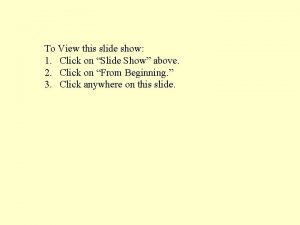To view this slide show 1 Click on









- Slides: 9

To view this slide show: 1. Click on “Slide Show” in the menu above. 2. Click on “From Beginning. ” 3. Click anywhere on this slide.

How to Use Visual Models to Find Equivalent Fractions Dawn Galente, Arlington CSD 2012 This is a self-paced tutorial. Click the screen each time you want to see the next step. Click to Start

Standard 4. NF. 1 Explain why a fraction a/b is equivalent to a fraction (n x a)/(n x b) by using visual fraction models…. use this principle to recognize and generate equivalent fractions. Start with a simple fraction like 1/3. = 1 3 Picture what this model would look like if we broke each part into 2 equal pieces. What fraction would this new model represent? = 2 6 This model represents 2/6 because 2 out of 6 pieces are now shaded.

I can find any number of equivalent fractions by simply breaking each piece in the model into smaller pieces. Start with 1/3… break each piece into 4 equal pieces… to get 4/12. x 4 1 = x 4 3 4 12 I have four times as many shaded pieces now; 1 x 4= 4. I have four times as many total pieces now… 3 x 4 = 12.

Here’s another example. Start with ¾. What happens if we break each piece into 3 equal pieces? We get 9/12. x 3 3 = x 3 4 9 12 Now I have three times as many shaded pieces: 3 x 3 = 9 shaded. Now I have three times as many total pieces: 4 x 3 = 12 total.

What if I want to find a specific equivalent fraction? 3 5 Start with a model of the first fraction. Think: I have 5 total pieces now. I need 10 total pieces. How can I break 5 pieces into smaller pieces so that I have 10? Break them into 2 pieces each! How many shaded pieces do I have? 3 x 2 = 6. x 2 3 = x 2 5 6 10 = ? 10

What if I want to find a specific equivalent fraction? 2 3 Start with a model of the first fraction. Think: I have 2 shaded pieces now. I need 6 shaded pieces. How can I break 2 pieces into smaller pieces so that I have 6? Break them into 3 pieces each! Now how many total pieces do I have? 3 x 3 = 9. x 3 2 = x 3 3 6 9 = 6 ?

a/b is equivalent to (n × a)/(n × b) means…. . 3 = 3 x 3 = 9 x 3 4 4 12 x n a =a x n b b

The End

















